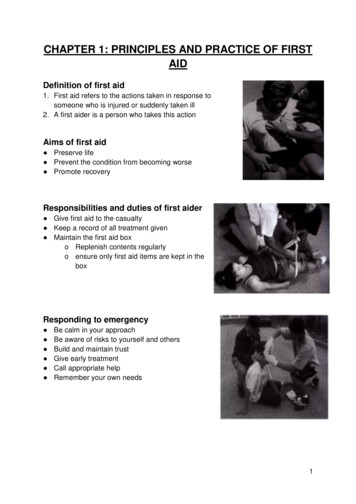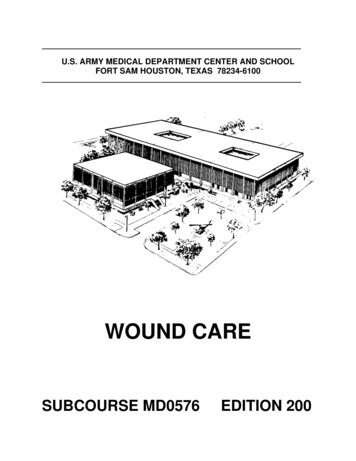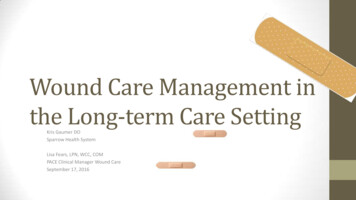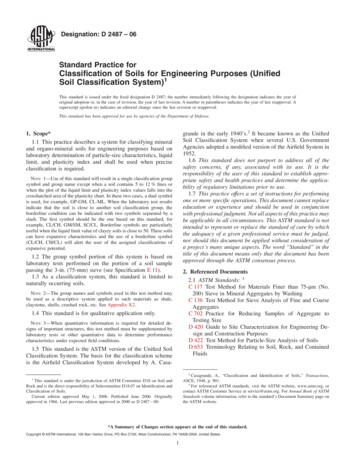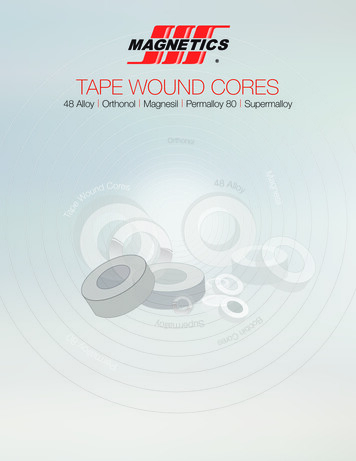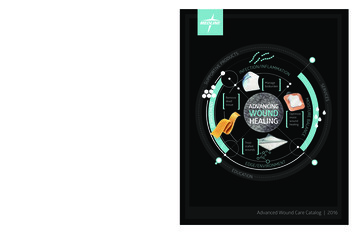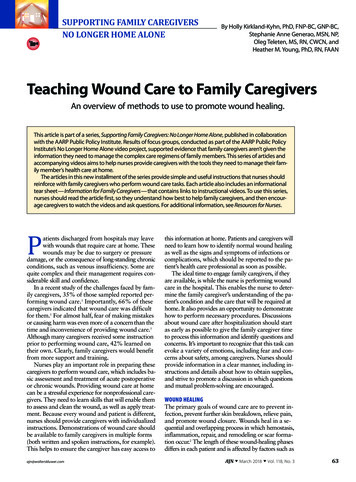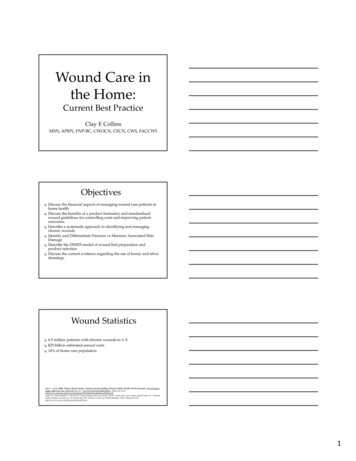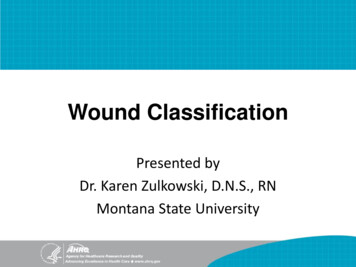
Transcription
Wound ClassificationPresented byDr. Karen Zulkowski, D.N.S., RNMontana State University
Welcome!Thank you for joining this webinar about how toassess and measure a wound.2
A Little About Myself Associate professor at MontanaState University Executive editor of the Journal of theWorld Council of EnterstomalTherapists (JWCET) and WCETInternational Ostomy Guidelines(2014) Editorial board member of OstomyWound Management and Advancesin Skin and Wound Care Legal consultant Former NPUAP board member3
Today We Will Talk About How to assess a wound How to measure a woundPlease make a note of your questions. YourQuality Improvement (QI) Specialists will followup with you after this webinar to address them.4
Assessing and Measuring Wounds You completed a skin assessment and found awound. Now you need to determine what type ofwound you found. If it is a pressure ulcer, you need to determinethe stage.5
Assessing and Measuring WoundsThis is important because— Each type of wound has a different etiology. Treatment may be very different.However— Not all wounds are clear cut. The cause may be multifactoral.6
Types of Wounds Vascular (arterial, venous, and mixed) Neuropathic (diabetic) Moisture-associated dermatitis Skin tear Pressure ulcer7
Mixed EtiologiesMany wounds have mixed etiologies. There may be both venous and arterialinsufficiency. There may be diabetes and pressurecharacteristics.8
Moisture-Associated Skin Damage Also called perineal dermatitis, diaper rash,incontinence-associated dermatitis (oftenconfused with pressure ulcers) An inflammation of the skin in the perinealarea, on and between the buttocks, intothe skin folds, and down the inner thighs Scaling of the skin with papule and vesicleformation:– These may open, with “weeping” of the skin,which exacerbates skin damage.– Skin damage is shallow or superficialand edges are irregular or diffuse.– Maceration or a whitening of skin mayalso be observed. Results when epidermis is damaged andbacteria are then able to penetratebeneath the surface9
Moisture-Associated Skin DamageDetermine what it is.Is it pressure or moisture? May be difficult todistinguish betweenmoisture-associated skindamage and pressureulcer. Unlike moistureassociated skin damage, apressure ulcer usually hasdistinct edges.MoisturePressure10
Pressure Ulcers From OtherSources of Pressure Boots, boot straps,oxygen/endotrachealtubes, stockings, andother devices can alsolead to pressure-inducedischemia on the skin. These are countedseparately for incidenceand prevalence.11
2009 Pressure Ulcer Definition“ localized injury to the skin and/or underlyingtissue usually over a bony prominence, as aresult of pressure, or pressure in combinationwith shear.”NPUAP/EPUAP Pressure Ulcer Prevention and Treatment Guidelines.12
Pressure Perpendicular force—– Compresses tissue– Restricts blood flow– Causes ischemia andnecrosis– Ruptures cells andvessels– Causes tissuedeformation13
Shear Force parallel to theskin—– Stretches and distortsinternal tissue– May cause occlusion ofvessels perpendicular toskin surface Leads to ischemia andnecrosis14
Pressure Ulcer Staging Concepts NPUAP classification system:– 6 stages or categories: Stage IStage IIStage IIIStage IVUnstageableSuspected deep tissue injury (sDTI) Base staging on the type of tissue visualized orpalpated. Do not reverse stage when documenting ahealing pressure ulcer.15
Staging is based on the type of tissuevisualized or palpatedQUICK GUIDE FORPartial thickness ulcerPRESSURE ULCER STAGINGStage IIntact skin with nonblanchable redness of alocalized area usually overa bony prominenceStage IILoss of dermis presenting as ashallow open ulcer with a redpink wound bed oropen/ruptured serum-filledblister.Suspected deep tissue injuryPurple or maroon localized area ofdiscolored intact skin or blood filledblister due to damage of underlyingsoft tissue from pressure and/or shear.UnstageableFull thickness ulcerBase of wound is covered bydead tissueStage IIISubcutaneous fat may bevisible but bone, tendon, ormuscle are not exposed. Zulkowski, 2012Stage IVExposed bone, tendon ormuscle.16
Stage IDefinition Intact skin with nonblanchableredness of a localized area, usuallyover a bony prominence.– Darkly pigmented skin may not havevisible blanching; its color may differfrom the surrounding area.Description Area may be more painful, firm, orsoft, or warmer or cooler thanadjacent tissue. Stage I may be difficult to detectin persons with dark skin tones.Source: National Pressure Ulcer Advisory Panel17
Stage IIDefinition Partial thickness loss of dermispresenting as a shallow open ulcerwith a red/pink wound bed,without slough. May also present as an intact oropen/ruptured serum-filled or serosanguineous filled blister.Description Presents as a shiny or dry shallowulcer without slough or bruising. This stage should not be used todescribe skin tears, tape burns,incontinence-associated dermatitis,maceration, or excoriation.Source: National Pressure Ulcer Advisory Panel18
Stage IIIDefinition Full thickness tissue loss. Subcutaneous fatmay be visible but bone, tendon, or muscleare not exposed. Some slough may bepresent. May include undermining and tunneling.Description The depth of a stage III pressure ulcervaries by anatomical location.– The bridge of the nose, ear, occiput, andmalleolus do not have “adipose”subcutaneous tissue and stage III ulcers can beshallow.– In contrast, areas of significant adiposity candevelop extremely deep stage III pressureulcers. Bone/tendon is not visible or directlypalpable.Source: National Pressure Ulcer Advisory Panel19
Stage IVDefinition Full thickness tissue loss with exposedbone, tendon, or muscle.– Slough or eschar may be present. Often include undermining and tunneling.Description The depth of a stage IV pressure ulcervaries by anatomical location.– The bridge of the nose, ear, occiput, andmalleolus do not have “adipose”subcutaneous tissue and stage IV ulcers can beshallow. Stage IV ulcers can extend into muscleand/or supporting structures (e.g., fascia,tendon, or joint capsule), makingosteomyelitis or osteitis likely to occur.Exposed bone/tendon is visible or directlypalpable.boneSource: National Pressure Ulcer Advisory Panel20
UnstageableDefinition Full thickness tissue loss in which actualdepth of the ulcer is completelyobscured by slough (yellow, tan, gray,green, or brown) and/or eschar (tan,brown, or black) in the wound bed.Description Until enough slough and/or eschar isremoved to expose the base of thewound, the true depth cannot bedetermined but it will be either a StageIII or IV. Stable (dry, adherent, intact withouterythema or fluctuance) eschar on theheels serves as “the body’s natural(biological) cover” and should not beremoved.Source: National Pressure Ulcer Advisory Panel21
Suspected Deep Tissue InjuryDefinition Purple or maroon localized area ofdiscolored intact skin or blood-filled blisterdue to damage of underlying soft tissuefrom pressure and/or shear.Description The area may be preceded by tissue that ispainful, firm, mushy, or boggy, or warmeror cooler than adjacent tissue. Deep tissue injury may be difficult todetect in individuals with dark skin tone. Evolution may include a thin blister overdark wound bed. The wound may furtherevolve and become covered by thin eschar. Evolution may be rapid, exposingadditional layers of tissue even withtreatment.Source: National Pressure Ulcer Advisory Panel22
Suspected Deep Tissue Injury Difficult to say with certainty as outer skinmay be intact.– Sometimes it really is a bruise.– Damage is to deeper tissue and when you seepurplish area it is too late to prevent. Better to document exactly what you see thanhave a facility-acquired wound.Bruise23
Causes of sDTI Falls Long OR/ER or transportation times Splints Accidents24
Medical Device-Related Pressure Ulcers 9.1% of all identifiedpressure ulcers 11.9% of facilityacquired pressureulcersMost frequent locationsAnatomic LocationPercentage ofDevice-RelatedPressure UlcersEars20%Sacral/coccyx region17%Heel12%Buttocks10%25
Remember the Bariatric Patient Check between the skin foldsand thighs:– Rash– Maceration– Infection (bacteria orcandidiasis)– Breakdown Pressure ulcers may be inunusual locations.26
Assess the WoundTTissue both in and around the wound—granulation, slough, necrotic black, pink, mix.IInfection. Any open area always has thepotential for infection.MMoisture (exudate). This determines type ofdressing needed to maintain balance.EEdges. Are they contracted, rolling,undermining?27
Pressure Ulcer PresentDocument Length, width, and depth Location Stage Exudate (amount, color, and consistency) Tunneling and/or undermining % of each type of tissue in wound (granulation,epithelial, eschar, slough, fibrinous) Wound edges (attached, not attached, rolledunder, irregular, callous)28
Know Your Assessment Terms Eschar. Cornified or dried out dead tissue. Slough. Liquefied or wet dead tissue. Undermining. Bigger area of tissuedestruction than can be seen (extends underthe edge). Tunneling. Tracts extending out from thewound.29
How To Measure a WoundUnderminingTunneling30
How To Measure a WoundMeasure widestwidth of thepressure ulcerside to sideperpendicular(90 angle) tolength.HeadToe31
Depth Moisten a cotton-tipped applicator withnormal saline solution or sterile water. Place applicator tip in deepest aspect of thewound and measure distance to the skin level.32
Epithelial Tissue1 Ayello, 201333
Slough3 Ayello, 201334
Necrotic Tissue (Eschar)Eschar4 Ayello, 201335
Skin Failure at Life’s End Kennedy terminal ulcer:– Pressure ulcers may develop right before death.– Some people now say this is skin failure at life’send36
Selecting Dressings and TreatmentBased on— Overall medical condition of patient Location of wound Size of wound Wound etiology Wound bed tissue involvement Exudate amount Pain management Living arrangements37
Care PlanningSKIN ASSESSMENT RISK ASSESSMENT EFFECTIVE / COMPREHENSIVE CARE PLANNING38
Today We Talked About How to assess a wound How to measure a wound39
Any Questions?Thank you for being such great listeners.Please refer any questions you have to your QISpecialists.40
Resources Berlowitz D, VanDeusen C, Parker V, et al. Preventingpressure ulcers in hospitals: a toolkit for improvingquality of care. (Prepared by Boston University Schoolof Public Health under Contract No. HHSA290200600012 TO #5 and Grant No. RRP 09-112.)Rockville, MD: Agency for Healthcare Research andQuality; April 2011. AHRQ Publication No. 11-0053-EF. VanGilder C, Amlung S, Harrison P, et al. Results of the2008-2009 International Pressure Ulcer PrevalenceSurvey and a 3-year, acute care, unit–specific analysis.Ostomy Wound Manage. 2009;55(11):39-45.41
Cornified or dried out dead tissue. Slough. Liquefied or wet dead tissue. Undermining. Bigger area of tissue destruction than can be seen (extends under the edge). Tunneling.
